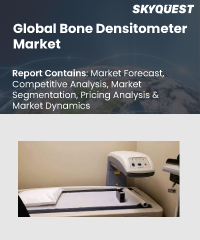
Product ID: SQMIG35A2731

Report ID:
SQMIG35A2731 |
Region:
Global |
Published Date: February, 2024
Pages:
157
|
Tables:
86 |
Figures:
76
Bone Densitometer Market size was valued at USD 41.5 billion in 2022 and is poised to grow from USD 43.21 billion in 2023 to USD 59.59 billion by 2031, at a CAGR of 4.1% during the forecast period (2024-2031).
The global Bone Densitometer market has witnessed significant growth and advancements in recent years. The global Bone Densitometer market is a dynamic and rapidly evolving sector within the medical device industry. The rising prevalence of osteoporosis, coupled with an increasing awareness about early detection and prevention, has been driving the demand for bone densitometers worldwide. Technological advancements in bone densitometry have played a crucial role in the market's growth. Traditional dual-energy X-ray absorptiometry (DXA) remains the most widely used technique, offering accurate and reliable measurements. However, other modalities, such as quantitative computed tomography (QCT) and peripheral DXA, have gained prominence due to their ability to assess bone density in various skeletal sites. The market for bone densitometers is highly competitive, with several key players operating globally. These companies focus on research and development to introduce innovative and user-friendly devices that provide accurate measurements while minimizing radiation exposure. Additionally, efforts are being made to develop portable and point-of-care devices, enabling convenient screening and monitoring of bone health in various clinical settings. Factors such as the aging population, rising incidence of osteoporosis, and increasing emphasis on preventive healthcare are expected to drive the growth of the global bone densitometer market in the coming years. Additionally, technological advancements, the development of portable devices, and expanding applications in research and clinical trials are likely to contribute to market expansion. In conclusion, the global bone densitometer market is witnessing steady growth driven by factors such as the rising prevalence of osteoporosis, technological advancements, and increasing awareness about bone health. The market is expected to continue expanding as the demand for accurate and early diagnosis of bone-related conditions remains high.
Our industry expert will work with you to provide you with customized data in a short amount of time.
REQUEST FREE CUSTOMIZATIONWant to customize this report? This report can be personalized according to your needs. Our analysts and industry experts will work directly with you to understand your requirements and provide you with customized data in a short amount of time. We offer $1000 worth of FREE customization at the time of purchase.

Product ID: SQMIG35A2731